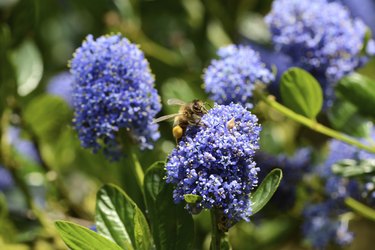
Ceanothus (Ceanothus spp.) and its numerous species go by many regional common names, from New Jersey tea and California lilac to ceanothus. Understanding their pruning guidelines is essential — missteps put an end to flowering and regrowth. These varied plants are hardy from U.S. Department of Agriculture plant hardiness zones 4 through 10. Some are evergreen, but others drop their leaves. Some bloom on old wood, some on new wood or on both. From spreading ground-huggers to espalier-ready trees, successful ceanothus pruning requires timing and technique matched to the plant and the task before you.
Pruning for Flowers
Video of the Day
Most ceanothus varieties flower in spring on stems grown the previous year. The flower buds develop on this older wood during the previous summer and fall. Some ceanothus trees also enjoy a second, smaller flush of late-summer blooms on the current season's new stems. Still other varieties flower heaviest in fall.
Video of the Day
To keep ceanothus flower blooms on schedule, prune spring-flowering evergreen and deciduous ceanothus right after they finish flowering. Prune late-summer or fall bloomers in late winter or early spring before new growth begins. Limit pruning to the flowering tips and small stems less than 1/4 inch in diameter. Avoid cutting back into larger stems.
Pruning a Ceanothus Tree
Evergreen ceanothus generally need little pruning other than a quick, post-flower shaping. For more intensive thinning, limit pruning to 1-inch-diameter or smaller stems. Focus on soft stems and the new year's shoots, and avoid woody branches. Large branches may not regrow if pruned.
Work from the center of the plant outward according to the University of California, removing crowded or crossing branches and shortening the tips. Keep in mind that your results may be permanent, especially in evergreen species. Deciduous ceanothus respond better to pruning, but exercise the same pruning cautions. Prune right after flowering or during winter dormancy. Remove dead and damaged branches any time.
Major Ceanothus Rejuvenation
In general, deciduous ceanothus tolerate harsh pruning, while evergreen species do not, but that doesn't hold true across the board. Before cutting ceanothus back severely, understand your particular plant. Some evergreen ceanothus lack the buds at their base to generate new stems. Cut back completely, they remain stumps.
Evergreen species that have woody swellings at their base, known as burls, respond and regrow well. These same species bounce back from wildfires with new crown growth. Species that lack burls — and the water, nutrients and plant energy they store — lack the buds needed for new stems. Undertake major rejuvenation pruning in winter while ceanothus is dormant.
Tools for the Task
Never prune ceanothus without a specific goal and proper tools for the chosen task. Use sharp pruning implements for crisp cuts that heal quickly and look clean — in case no regrowth comes. Handheld bypass pruners work best for small stems less than 1/2 inch in diameter.
Bypass loppers provide the extra leverage needed for branches between 1/2 and 1 1/2 inches. Use a curved pruning saw for clean removal of larger stems involved in rejuvenation.
Wear gloves and safety goggles, even for light pruning, and sanitize pruner blades with alcohol before making each cut. Wear long sleeves and long pants for added protection against ceanothus with spiny leaves.
- Royal Horticultural Society: Ceanothus
- San Marco Growers: Ceanothus: California's True Blues
- Missouri Botanical Garden: Ceanothus
- Monrovia: Ceanothus, by USDA Hardiness Zones
- Lady Bird Johnson Wildflower Center: Ceanothus Americanus
- University of California: Ceanothus — Wild Lilac
- Las Pilitas Nursery: California Lilacs (Ceanothus Spp.)